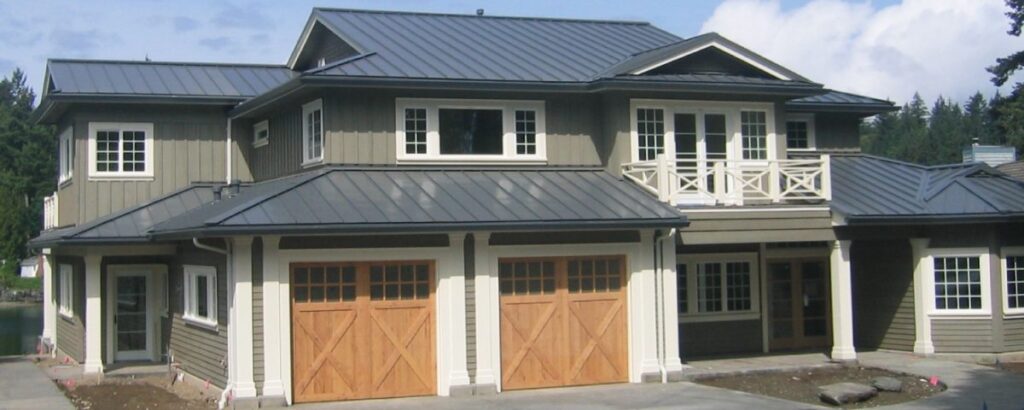

With the many different roof styles to choose from, picking a roof style that is both within your budget and matches your homes style can be a difficult choice. Given that the roof of your home should last 20 years or more, choosing from the multitude of roof styles available can be a difficult task. Another factor to consider is the durability of each style of roof. Given the fact that one of the most important structures of a house is its roofing, its design is one to bear in mind when building and designing your home. There are different styles of roofing structures, and every style has its distinct benefits.
Irrespective of the style you choose, every roof needs proper care to maintain its aesthetic value. It is the homeowner’s duty to inspect and do the necessary roof repairs, instead of waiting for the damage to get worse. If you are uncomfortable inspecting the roof of your house, or cleaning the gutters, give CRS Roofing a call. We will get you scheduled for an appointment as soon as possible, and one of our professional roofing contractors will handle everything for you at an amazing price!
Roof styles vary from area to area, and each of the varying designs, shapes, and styles have been created to accommodate the needs of the structure they are covering.
For those constructing a new house or considering roof replacement, listed below are the different gradations and styles of roofing you can choose from.
Gambrel Roof
Though most commonly used as roofing for barns, this Dutch-inspired roof is also used in residential construction. A gambrel roof has vertical gable ends with the roof hanging over the facade of the home. This kind of roofing structure will provide you a good amount of space in the attic, so much so that it allows for the attic to be converted to a bedroom, office, or any other type of bonus room you desire. also They are a great idea for outdoor sheds and storage buildings. The construction of this roofing is quite simple for a trained professional, and it helps to keep the cost of a roof low. They are mostly seen on Dutch Colonial and Georgian style homes.
Gable Roof
These roofs are among the most popular styles of roof you can put on your home. They are also known as pitched or peaked roofs. They are easy to spot given their triangular structure. Depending on the style of roof you choose, their simple structure means they are easier and cheaper to build than other roof types. They are also great for regions with high rain and snow as their structure makes it easy to shed snow and water, and provides additional space for an attic or vaulted ceilings, with more ventilation. However, they can be a tad risky in windy and hurricane situations. If the frames do not have adequate support, the roof can collapse during high winds, and it can also cause materials to peel away from the roofs. The professionals at CRS Roofing will ensure proper braces are used during installation. After a storm, be sure to get the roof inspected.
Hip Roof
The hip roof is relatively difficult to construct as compared to flat and gable roofs. They have a complicated truss and rafter structure. This roofing structure has four sloping sides with no vertical roof lines or walls. The four sides meet at a ridge or a flat spot. They come in both square and rectangular shapes. There is also the Dutch hip roof, which is basically a hip roof with a small gable at either end that can be used as ventilation. They are more stable than a gable roof, as the inward slope of its four sides makes it very durable and sturdy. They are perfect for both high wind and snowy regions because the slant of the roof allows snow to easily slide off and leaves no standing water.
Mansard Roof
This French inspired design is a more complicated structure than the hip or gable roof. It is made up of four slopes, two on each side of the house, with the lower slope being steeper and more vertical than the upper slope. The upper slope is usually not visible from the ground. This French style roof allows the homeowner to incorporate additional living space or storage space on top of their house. This style also lends itself to open or closed dormers to enhance the home’s aesthetic appeal. If you are looking for flexibility, with regard to future renovations, then this is an ideal option as you can have a simple type to start off with and then make garret additions later on.
Pyramid Roof
As the name suggests, here the roof is structured in the shape of a pyramid. Very similar to the hip roof, all the four sides come to a merging point at the top of the roof. There are no vertical sides or gables in this structure. This kind of roofing is mostly popular with smaller buildings like bungalows and cabins. They even find a place among auxiliary structures like pool houses and garages. Extremely resistant to strong winds, they make for an excellent architectural choice for hurricane prone and high wind areas. The slopes provide additional space for ventilation. While the complexity of its design may increase its cost, the eaves reduce energy costs.
Saltbox Roof
This roof lends an interesting appeal to the exterior of a house with its asymmetrical long pitched roof, with one short side and one very long side. This makes one side a slightly sloping roof and the other side a more lean-to style roof, with gables at each end, resulting in a house that is one story in height on one side, and two stories on the other. This colonial and Cape Cod design arose from the need of adding more space with less materials, which was achieved by adding a lean-to roof to an existing gable roof. Houses in areas that receive heavy rain can benefit from saltbox roof as the slope makes it easy for the water to run off. It is also more durable than a simple gable roof, thanks to its asymmetrical design.
Flat Roof
True to its name, these roofs are completely flat with just a slight pitch to allow water run-off. Though mainly popular with industrial and commercial buildings, it is also widely used in residential houses, both in the high and low rainfall areas. Choosing a flat roof means ease of construction, safety if you have to get on top of your roof, and a more accessible rooftop. The heating and cooling units can be placed on flat roofs to keep them out of sight. However, it requires relatively more maintenance as debris can gather on the roof with nowhere to go.
Bonnet Roof
Also known as kicked-eaves, bonnet roofs are double sloped roofs, with the lower slope set at less of an angle than the upper slope. This makes it Mansard roof in reverse. The major purpose of this kind of roofing is to cover a veranda or an outdoor porch area as the lower slope hangs over the side of the house. The overhanging eaves can also protect your walls from water damage, as water can easily run off the slopes. Its modified hip structure renders it more durable than a gable roof. The upper slope provides extra room for a small attic or vaulted ceilings.
Skillion Roof
Also referred to as a shed roof or lean-to, it is a single, sloping roof attached to a taller wall. These roofs are mostly used for additions to the homes, and for sheds and porches. However, many modern style homes are using it for their entire structure. Skillion roofs are easy to assemble, and use much less building materials compared to other roof styles. They are ideal for homes in high rain and snow regions as their steep pitch allows snow and water to run off easily. If you are looking to give your home a unique twist, then this roof gives you the scope to do so. Given their distinct shapes and patterns, this roof will add an interesting architectural appeal to your home’s exterior.
While selecting your roof style, apart from the aesthetic appeal you desire it to lend, also keep in mind the practical aspects of a particular style. Based on that, it is easier to narrow down your choices to the most efficient and cost-effective style for your home.
No matter the style of your roof, you have to check on it regularly to see if there are any signs of damage. Getting the roof repair done when you see the minor signs will save you heaps of trouble and money in the future.

Keep these factors in mind, and you can enjoy the roof of your dreams for a long time to come!
Contractor's Roof Service, Inc.
4600 Neel Ct, Ste B
Gig Harbor, WA 98335
Tel: 253-858-3044
#CONTRRSO35B8/WA
#216800/OR